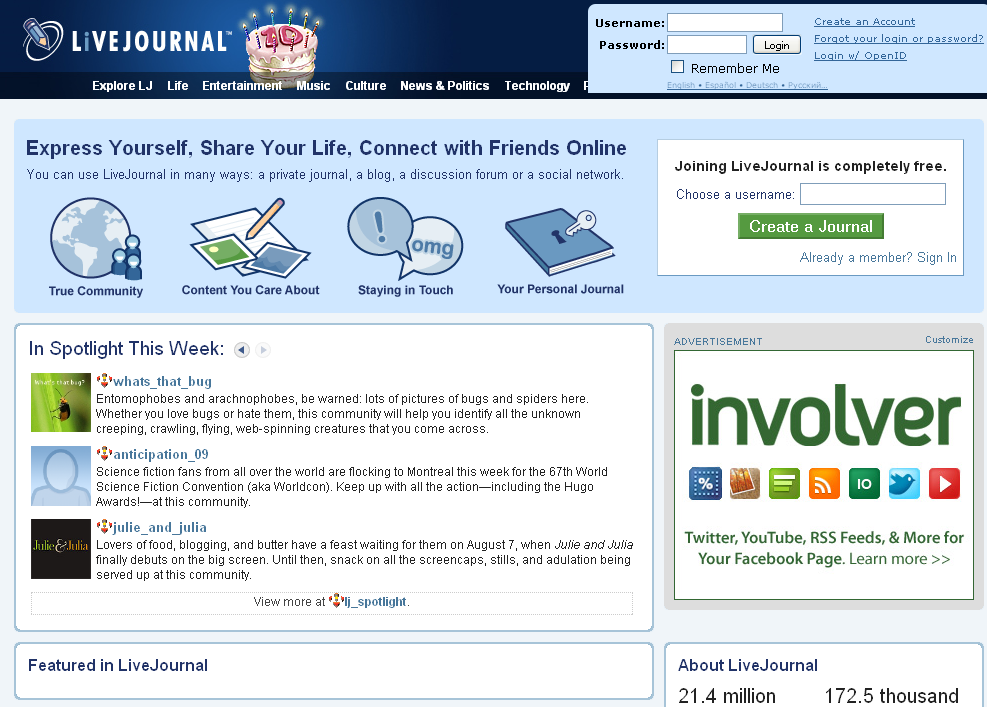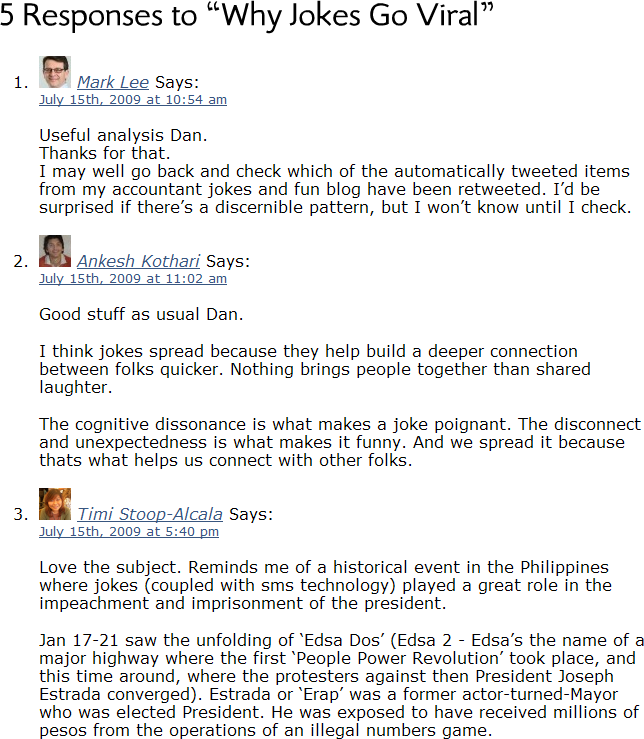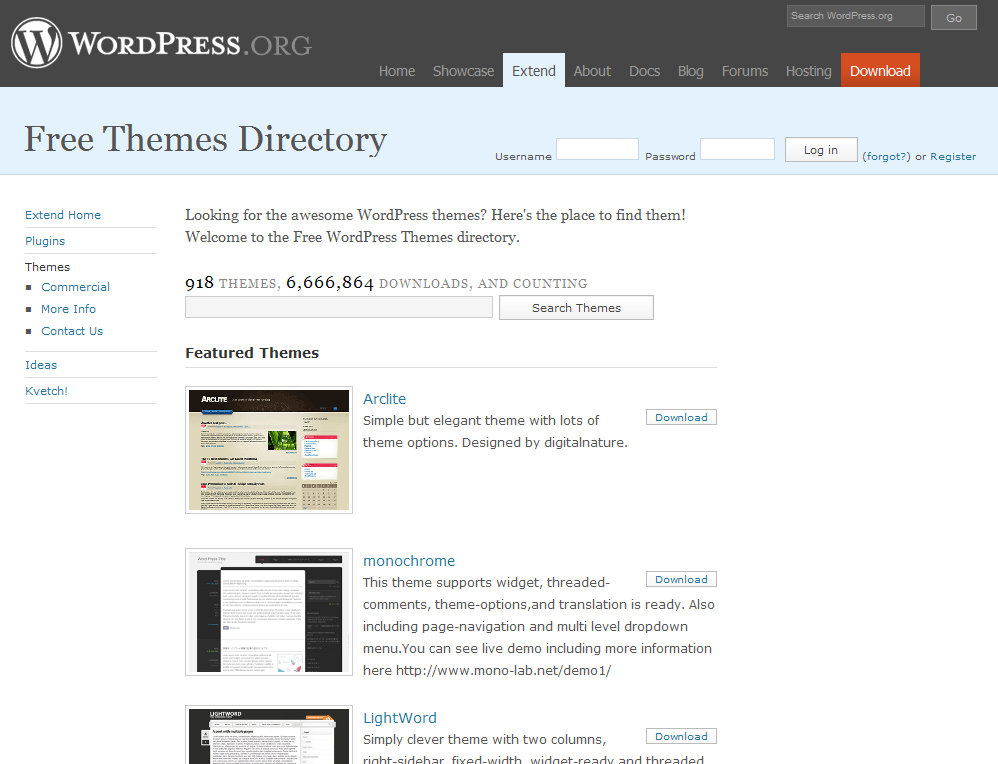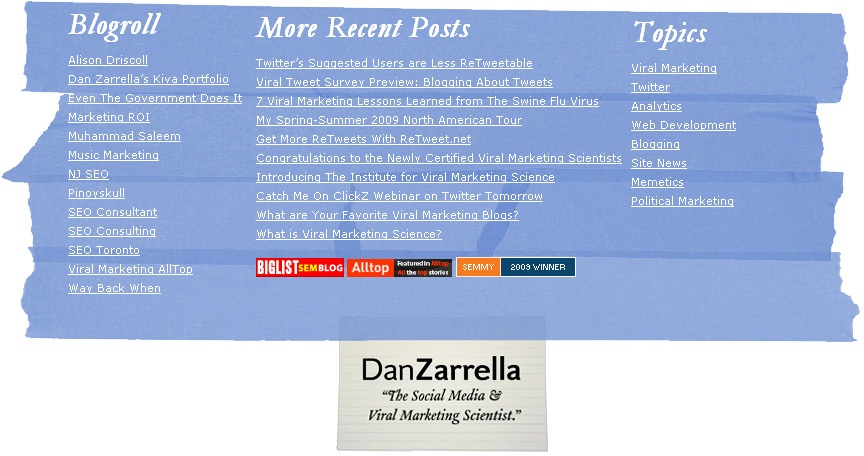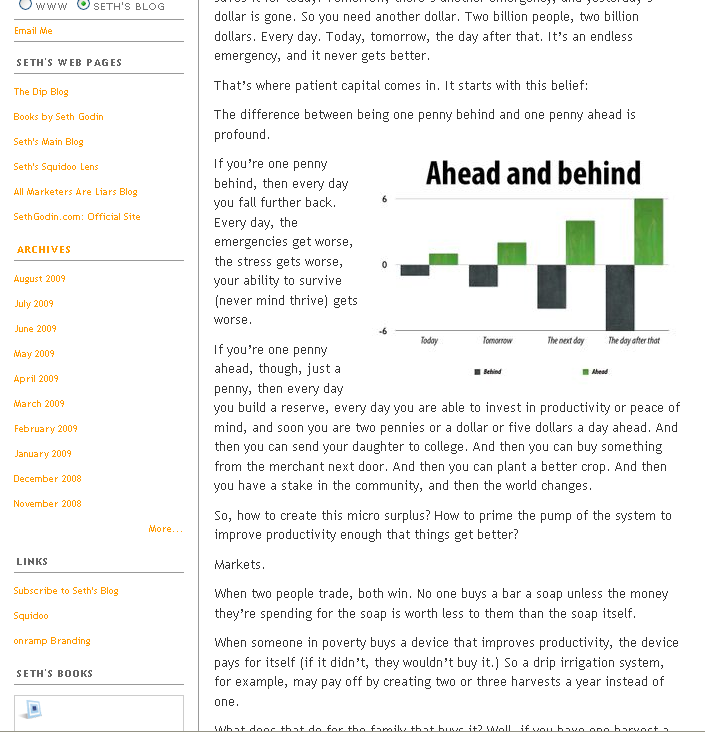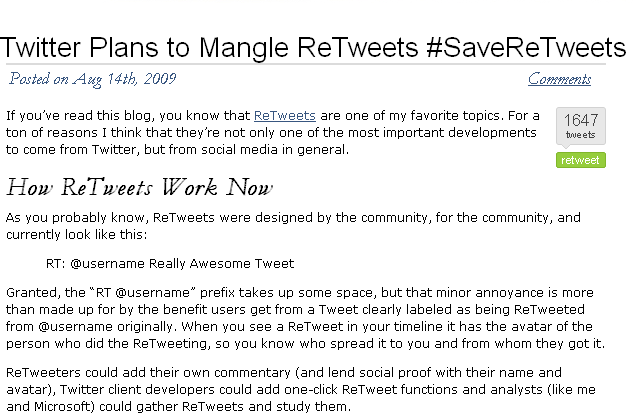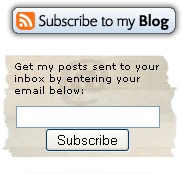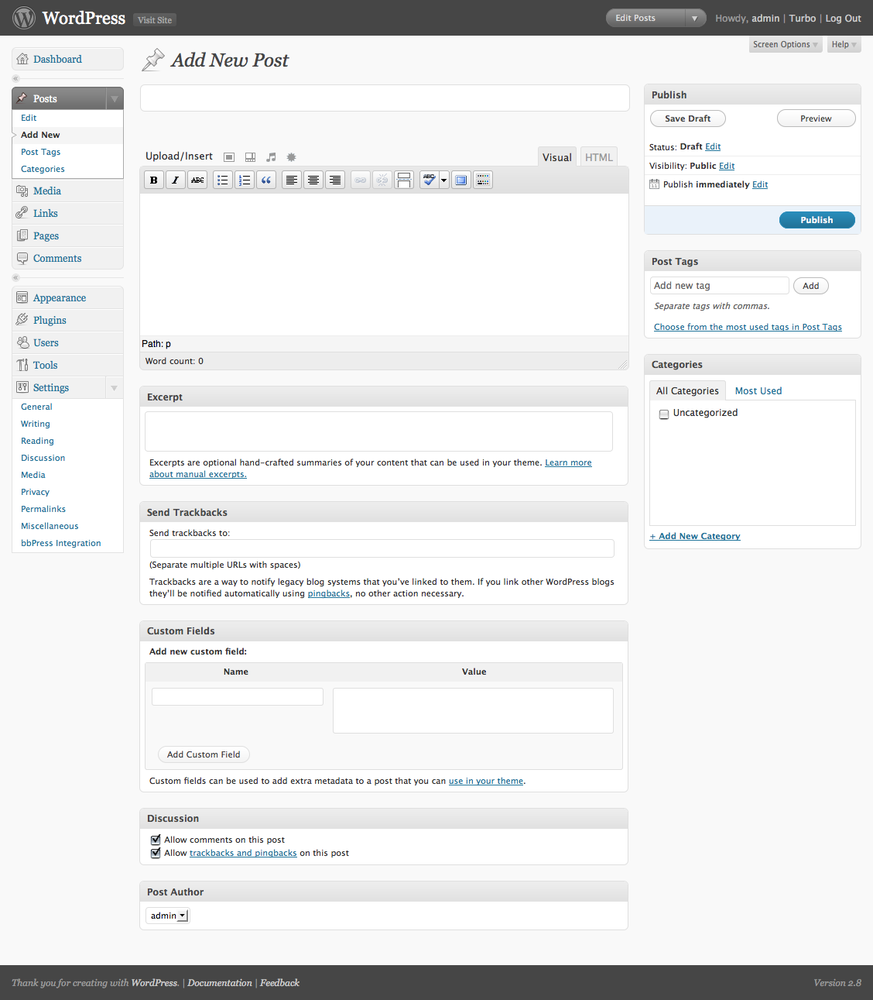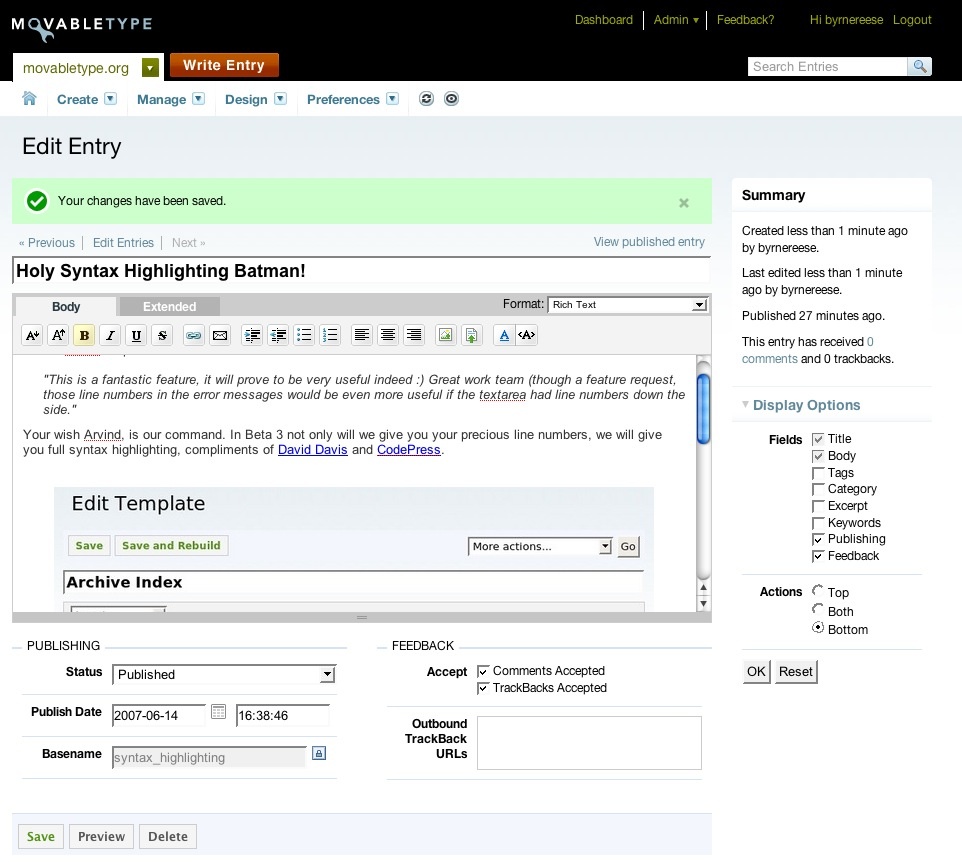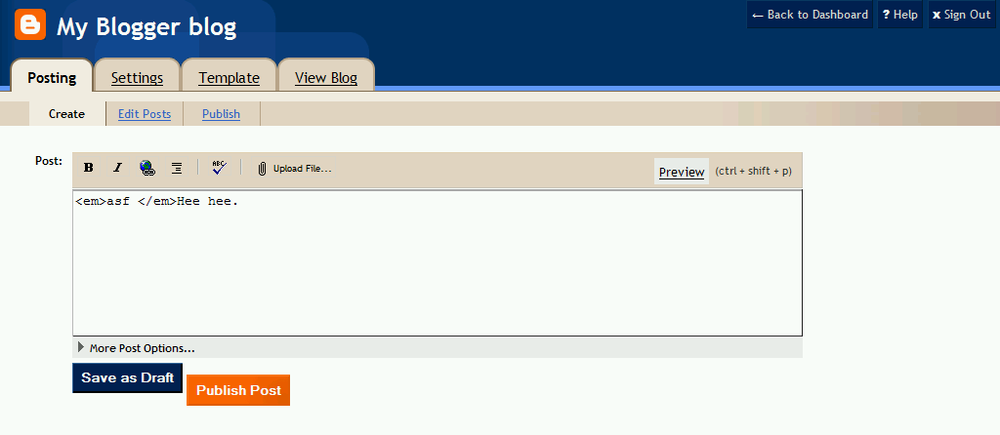A blog is a type of content management system (CMS) that makes it easy for anyone to publish short articles called posts. Blog software provides a variety of social features, including comments, blogrolls, trackbacks, and subscriptions that make it perfect for marketing purposes. Blogs make great hubs for your other social media marketing efforts, as they can be integrated with nearly every other tool and platform.
Every company with a website should have a blog that speaks to its current and potential customers as real people. Blogs are not the right place for corporate-speak press releases; blogs should be conversational in tone. Every time your company does something new or cool, write a quick post about it. Blog about your take on news that affects your industry. If a related blog posts something you think is particularly interesting or incorrect, link to it and add your thoughts.
People have been keeping journals for thousands of years (an example is Roman Emperor Marcus Aurelius), and have been able to write them online since 1994. Justin Hall, a student at Swarthmore College, was one of the first web diarists when he started writing about video games and gaming conventions in the mid-1990s. Originally, these journals were nothing more than parts of regular sites that were updated regularly, by hand, in HTML. The technical knowledge this required prevented the average person from starting an online diary.
In December 1997, the word weblog, a combination of the words web and log, was born; eventually, weblog was shortened to just blog. This is probably one of the least understood and most ridiculed words on the Web; I've heard people who should know better explain it as having come from a bunch of ridiculous origins (including business log).
Blogging didn't start to blossom until 1999, when LiveJournal (see Figure 2-1) and Blogger were launched, the latter by Evan Williams (who went on to create Twitter). Users could sign up to one of these two sites and start their own blogs for free, with no technical ability required. By the end of 2008, 346 million people were reading blogs, and 184 million had started one of their own.
Blogging platforms all share some common traits and features that make them blogs. In this section, I'll explain some of these characteristics and show you how you can use them for marketing.
Blogs are made of posts. A post can be any length, from 100 or 200 words to many pages, but to be most effective, it should always stick to a single topic.
Mashable is one of the five most popular blogs on the Web, according to Technorati, and is the leader in the social media niche. I asked founder Pete Cashmore for his advice on blogging, and he said the most important element of a successful blog is consistent, quality posts. Pete also suggested setting a goal, such as one post per day for a year, and then sticking to it.
In the early days of Mashable, Pete had a lot of success with huge collections of links to tools and resources called "God List" posts (see Figure 2-2). These took an enormous amount of time to create, but once they were written, they drew incoming links and traffic for years. Pete emphasized that if you're writing long posts, you need to structure them in such a way that they include "scannable" items such as subheadings, lists, and images.
On the opposite end of the spectrum is the short-form content that is often used to publish news and events. If you've committed to publishing regularly, quick posts of a couple hundred words can help you feel like you've accomplished something when writing feels like a chore. Pete recommends posting a mix of short and long posts.
Each post on a blog can be seen in a variety of places, including the home page, category page, and archive pages. These pages are dynamically generated, and as new posts are added old ones are buried. The one place where you can always find a specific post (and only that one post) is on its permalink page (see Figure 2-3). These permanent links are what you'll be promoting on Twitter or social news sites. Good blogging software should allow the URLs of these pages to be short and clean, without question marks or ampersands. Clean URLs also make it easier for search engines and users to consume your content.
Most blogs have a section below each post where users can leave comments (see Figure 2-4). This comment section is a great place to build a community and get feedback. Make an effort to respond to as many comments as you can, especially when your blog is first starting out. If someone leaves a negative comment that is based on a legitimate concern, respond to it, don't delete it. But if someone is being disruptive or offensive, feel free to delete the comment; this is your blog.
Spend some time each day posting thoughtful comments on other blogs in your industry. Pick a few well-known blogs that are relevant to yours, and become a valuable member of their communities. This is a great way to get connected to other people in your space, but you'll need to balance this with the time you spend creating your own quality content, as content trumps comments.
Because most blog platforms allow commenters to include a link to their sites, comments have become a favorite target of spammers. Your software should have a mechanism—such as a CAPTCHA—in place to prevent this. And when you're commenting on someone else's site, use your real name and leave out unnecessary links so that other bloggers don't think you're a spammer.
Popular comment sections are similar to forums, so check out Chapter 8 for a better understanding of how to grow and manage your own community as well as engage in other blogs.
Most blogging software allows you to customize the look of your site through the use of themes. Themes are collections of CSS, HTML, and graphics that can be applied to any blog using a specific platform. For example, a WordPress theme will work on any WordPress blog and will change the look of the content that is already there (see Figure 2-5).
Thousands of free and paid themes are available on the Web, but many of the most popular blogs have unique themes designed for them. The look of your site is vital to establishing an image of authority; you'll have a harder time gaining your readers' trust if you have an amateurish-looking or extremely common theme.
Posts are displayed in reverse chronological order; typically, only the most recent 10 or 20 posts will appear on a blog's home page. To make older posts easier to find, most blogging software includes archive pages where users can browse through past content by day, week, or month. Figure 2-6 shows an example of a monthly archive.
To organize posts by topic, rather than simply chronology, you should label each post with one or more categories or tags. Users can then browse your content by topic through the use of category pages, which are provided in most platforms (see Figure 2-7). When you're creating the list of categories for your site, think of a first-time user to your site: what topics would he want to navigate to first?
A blogroll is a list of links to other blogs that many bloggers have in their sidebars as recommendations. The understood meaning is that these are the sites the blogger reads regularly, but most modern bloggers read many more blogs than they can fit in their blogroll. A good way to use your blogroll is to link to popular sites in your niche in the hopes that those bloggers and their audience will notice and read your blog. But don't go crazy; try to keep your blogroll at around 30 links.
Links are the currency of blogging. Incoming links send traffic, of course, but they also help a site rank better in search engines. Because links are so highly sought after, most bloggers pay close attention to who is linking to them with blog search engines such as Technorati and Google Blog Search. In the blogosphere, links are a form of communication: if you link to me, I'll see it in a few hours and will probably read what you said about me. If I like it—or dislike it enough—I may respond. Either way, I now know your site.
Most blogging software sends trackbacks or pingbacks when you link to another blog. Simply put, these are notifications from one blog to another that the sender has pointed a link at the receiver. These were very popular when they were first invented, but they have since become overrun with spam, so most bloggers pay more attention to traffic or blog search engines.
TweetMeme.com offers a small piece of JavaScript that you can copy and paste into your posts that will show your readers how many people have tweeted about it as well as allow them easy, one-click retweeting of your content. Guy Kawasaki has called this the most important button on the Web. There are plug-ins for WordPress, TypePad, and Blogger that simplify integration. Figure 2-8 shows the TweetMeme button on a blog post.
Blog software gives you the powerful ability to syndicate your content using popular formats such as RSS and Atom. These standards are designed to allow people to read your content—as well as their other favorite blogs—in a piece of software known as a feed reader. Good blogging software makes this easy by providing people with a simple button to click to add your blog to their subscription lists. People who subscribe won't come to your site every time they read your content, but once they have subscribed to your feed, they will read most or all of your posts. Similar software, such as FeedBurner, converts your feeds into an email format so that your visitors can receive your posts in their inboxes (see Figure 2-9).
If your intended audience is tech savvy, you should emphasize feed-based subscriptions. If not, be sure to offer an email subscription option. Either way, display links to both methods prominently in your theme, as they will result in repeat visitors.
Blogs can be set up on a variety of platforms. This section will introduce the two types of platforms available, and detail some of the features of the specific choices.
Blogging software falls into one of two varieties: hosted or self-hosted. Hosted software, such as LiveJournal, resides on a server owned by the organization that maintains the code. Many hosted solutions will give you a URL to use, such as http://<example>.wordpress.com. Self-hosted software is run on your own server. Self-hosted platforms require installation and configuration, but once they are set up they're completely under your control. Blogs running self-hosted software are located on a domain owned solely by you, as opposed to the shared domains often used by hosted blogs. Hosted software is often easier for new bloggers to get started on, but for best results your blog should appear on your own domain. Some hosted blog systems allow you to use your own domain; take advantage of this if you can.
Most popular blogs today use self-hosted software, and chances are good that you'll need help installing, designing, configuring, and maintaining your blog to get it running to your needs. Rather than hire a dedicated in-house person to manage this for you, you should look for technical help in your industry or location. Mashable's Pete Cashmore recommends finding a firm or individual who would like to increase her exposure in your niche, and offering a trade of advertising space on your site and blog for free or discounted services.
WordPress is the most well-known and widely used blogging software, as well as my personal favorite. It is free, is open source, and has a robust community of developers and designers who've built thousands of plug-ins and themes for it, making it the most customizable platform available. Once WordPress is installed and set up, it is also one of the easiest to use, but as I mentioned before, you may need some technical help to get it up and running (see Figure 2-10).
Wordpress.com also offers a hosted version of WordPress software that can be used for free. If you're thinking of using WordPress for your blog, Pete suggests that you try a free account to see whether you like the platform.
Many of the most high-traffic blogs on the Web use Movable Type. In the past few years, Movable Type has shifted to an open source model and now has great support for multiple blogs, but it is not as easy to use as WordPress. The most popular paid, hosted platform on the Web is TypePad (see Figure 2-11). Based on Movable Type software and owned by the same company (Six Apart), TypePad is simpler to use than the self-hosted version and includes a few additional features. Some sites running on TypePad use domains such as http://<example>.typepad.com, whereas others use their own domains.
One of the earliest blogging platforms, Blogger is hosted software (see Figure 2-12); most sites using it appear on URLs such as http://<example>.blogspot.com. It is very easy to use, but it lacks many of the features available in other platform solutions. It is a popular choice for new bloggers creating their first sites.
Pete Cashmore told me he thinks the most important choice you'll make when starting your blog is to choose a topic you can dominate—avoid overcrowded areas that have a bunch of popular blogs, if you can. Regardless of the size of your niche, however, blogging is a personal medium, so focus on bringing your own voice and unique point of view forward. Local businesses also have the option of blogging about a topic in a geographic area; if you can't be the biggest law blog, you can be the biggest law blog in Minneapolis.
Once you've picked your niche, you'll need to put in the work. Mix up the kind of content you post, and focus on types of content that are known to drive traffic and links. In the following sections, I describe a few kinds of content that often do very well for new blogs and are easy ways to become accustomed to the medium.
The most popular kind of content you'll probably ever be able to publish is breaking, exclusive news (for an example, see Figure 2-13). The problem, of course, is that breaking news is pretty hard to come by. The best way to come into this kind of information is to establish real-world connections with people working in your industry. Of course, sometimes you may happen upon such information just by being in the right place at the right time: always keep your eyes and ears open.
When you do hear about something you can write about, act fast. There is very little benefit to publishing second or third. Get as many details and as much media—photos, videos, or audio—as you can, and then click Publish.
Readers find content that is broken into short bits easier to read than long blocks of boring text. Lists are a perfect example of this (see Figure 2-14). Rank the 10 best of a certain thing or the 10 worst. Find the 10 most expensive or the 10 weirdest. If you can, add an image or video example for each item, and list them in descending order.
Chances are good that you know how to do something others don't. So, write a tutorial about it. Add video or images, and break the steps down into a numbered list. The simpler you can make a seemingly complex task, the more your readers will thank you for it. Useful information is one of the most commonly shared types of content on the Web, so posts such as these are known to spread like wildfire.
First, a word of caution: anyone can stir the pot and inflame tempers. If you don't have a good argument, chances are you'll catch serious backlash if your attempt at creating baseless controversy works. That being said, if you can disprove or make a strong case against something that everyone likes, or if you are in favor of something that everyone dislikes, you may have a grand slam of a post on your hands. Don't maker personal attacks, and do stick to your facts. And, unless you want to be known as the person who is always looking for a scrap, don't make this a habit.
You've got a blog set up and you've picked a niche. You've written a few solid posts, and you're ready to roll, but no one's subscribing or commenting. What's missing? (Besides readers, of course.) You need to have an understanding of where these readers originate. Blogs are best thought of as hubs for your social media marketing efforts, and the other chapters in this book will teach you how to reach out to various communities; your blog is a good place to point the people you meet. Hopefully, you're among your target demographic, so ask yourself: where do you hang out online?
A crucial aspect of building an audience is connecting with other bloggers in your niche. I've already described two easy ways to do this: links and commenting. But you can also get to know them on other social sites, especially Twitter. I'm much more likely to link to you from my blog if I've had a conversation or two with you before.
Every company should have a blog, and it should be the center of your social marketing efforts.
Pick a niche you can own, stay away from crowded areas, and bring your unique voice.
Get a good design. Without one, you'll find it hard to be taken seriously.
Establish a consistent habit of regular posting, and stick to it.
Get to know other bloggers in your industry and become a valuable part of their community to increase the visibility of your own blog.

